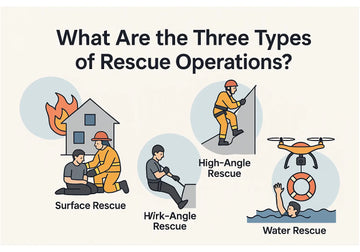Rescue operations are vital for saving lives during emergencies. Whether in natural disasters, industrial accidents, or maritime incidents, effective rescue operations can mean the difference between life and death. But did you know that rescue missions are typically classified into three main types? In this article, we’ll explore the three primary types of rescue operations, their unique challenges, and how modern technologies—like air-water drones—are transforming how we respond to emergencies.
1. Surface Rescue Operations
What is Surface Rescue?
Surface rescue refers to operations that take place on land or at ground level. This includes urban search and rescue (USAR), vehicle extrication, building collapse rescues, and responses to natural disasters such as earthquakes, tornadoes, and landslides.
Common Scenarios:
-
Car accidents and road emergencies
-
Structural collapses and fire evacuations
-
Trapped individuals in industrial zones
-
Earthquake debris clearance
Tools & Technologies Used:
-
Hydraulic rescue tools (e.g., “jaws of life”)
-
Thermal imaging cameras
-
Stretchers, rope systems
-
Ground robots and rescue drones
Key Challenges:
-
Accessibility to victims in collapsed structures
-
Limited time window in unstable environments
-
Need for multidisciplinary coordination (EMS, firefighters, engineers)
2. High-Angle or Vertical Rescue
What is High-Angle Rescue?
This type of operation involves rescuing individuals from elevated or vertical environments such as mountains, cliffs, tall buildings, towers, or trees. It is commonly required in hiking accidents, construction site emergencies, or rescue missions involving people stuck at heights.
Common Scenarios:
-
Mountain and canyon rescues
-
High-rise building evacuations
-
Rescue of paragliders or climbers
-
Workers stranded on cranes or towers
Equipment Involved:
-
Ropes, harnesses, and pulleys
-
Rappelling gear and anchor systems
-
Drones for overhead visual assessments
-
Communication radios and helmets
Key Challenges:
-
High physical risk to both victims and rescuers
-
Weather and wind conditions at altitude
-
Complex rope access planning and execution
3. Water Rescue (Including Air-Water Operations)
What is Water Rescue?
Water rescue involves retrieving individuals from aquatic environments such as rivers, lakes, oceans, flood zones, or reservoirs. It includes both shallow-water and deep-water rescues, and now increasingly incorporates air-water rescue technologies, such as drones.
Common Scenarios:
-
Drowning incidents in public swimming areas
-
Flood and tsunami evacuations
-
Boat capsizing or sea accidents
-
Rescue during heavy rainfall or dam failures
Tools & Technologies:
-
Life jackets, rescue boards, lifebuoys
-
Motorized boats or jet skis
-
Air-water rescue drones like the JX-6A
-
Sonar and underwater communication devices
Key Challenges:
-
Strong currents and poor visibility
-
Hypothermia risk to victims and responders
-
Limited access during storms or floods
-
Time-sensitive nature of drowning prevention
How Technology is Transforming All Three Rescue Types
Modern rescue operations are rapidly evolving with the help of advanced tools like drones, GPS tracking, and real-time video streaming. For instance, the JX-6A Air-Water Rescue Drone is revolutionizing water rescues by providing:
-
Remote-controlled deployment up to 1.1km away
-
190N buoyancy to support victims in water
-
HD camera for real-time search and tracking
-
Operation in wind speeds up to level 6
These innovations reduce risk for human responders and improve the chances of successful rescue—especially in complex or dangerous environments.
Final Thoughts
Understanding the three types of rescue operations—surface, high-angle, and water rescues—is crucial for anyone involved in emergency response, disaster preparedness, or rescue planning. Each type demands unique skills, tools, and technologies, but all share a common goal: saving lives quickly, safely, and effectively.
As technology continues to improve, integrating solutions like air-water rescue drones, smart monitoring, and automated systems will enhance how we perform life-saving missions across every environment.





